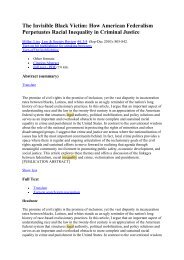Ski – resort and regional development: profile of visitors ... - E-Journal
Ski – resort and regional development: profile of visitors ... - E-Journal
Ski – resort and regional development: profile of visitors ... - E-Journal
Create successful ePaper yourself
Turn your PDF publications into a flip-book with our unique Google optimized e-Paper software.
88<br />
Onome Daniel Awaritefe<br />
RESULT PRESENTATION AND DISCUSSION<br />
Demographic Characteristics <strong>of</strong> Tourists<br />
Analysis <strong>of</strong> data in Table I was on tourists' demographic, social <strong>and</strong> cultural characteristics<br />
obtained from the first section <strong>of</strong> the questionnaire. This indicated that majority <strong>of</strong> the tourists<br />
were males, single, between the ages <strong>of</strong> 21 <strong>and</strong> 45 years, highly educated <strong>and</strong> earn more than<br />
N75, 000 monthly. Majority <strong>of</strong> the tourists were also Nigerians with others being Europeans<br />
from Western Europe, <strong>and</strong> Americans <strong>and</strong> Asians. Other Africans were few <strong>and</strong> from<br />
neighbouring West African countries. The largest proportion <strong>of</strong> tourists was also the working<br />
class, <strong>and</strong>. travelled in company <strong>of</strong> their spouses or family/relations.<br />
Tourism Product Dem<strong>and</strong> <strong>and</strong> Characteristics <strong>of</strong> Tourists<br />
Result <strong>of</strong> the measurements obtained on the 8 independent variables <strong>and</strong> the dependent variable<br />
<strong>of</strong> tourism product dem<strong>and</strong> is summarized in a multiple regression model as follows:<br />
TPD = 9.3 + 2.2 (OCCP)- 2.31 (ED) + 0.24 (INC) + 3.95 (SEX) - 0.097 (AGE) - 0.05 (CULNT) +<br />
0.002 (FAMSZ) + 0.043 (SOGR).<br />
Where: TPD = Tourism Product Dem<strong>and</strong>; OCCP = Occupation <strong>of</strong> tourists; Ed = Education; INC =<br />
Income; CULNT = Culture/nationality; FAMSZ = Family size; <strong>and</strong> SOGR = Social<br />
Group/Company during travel.<br />
The above regression equation indicates that among the 8 variables <strong>of</strong> demographic, social<br />
group <strong>and</strong> cultural characteristics <strong>of</strong> tourists, the ones that contributed highest to determining<br />
variation in tourism product dem<strong>and</strong> within the tourism destinations are education, sex, <strong>and</strong><br />
occupation/socio-economic status. Other variables such as family size, social group, income,<br />
<strong>and</strong> age contributed less in their influence on tourism product dem<strong>and</strong>, though tourism product<br />
dem<strong>and</strong> was not positively influenced by age <strong>and</strong> education <strong>of</strong> tourist. Thus, while tourists<br />
with high education <strong>and</strong> older tourists did not necessarily patronise tourism products most,<br />
it was those with high income, medium family size <strong>and</strong> <strong>of</strong> certain social group, sex <strong>and</strong><br />
culture/nationality that patronised.<br />
However, the eight independent variables on both demographic, social group, <strong>and</strong> cultural<br />
characteristics <strong>of</strong> tourists accounted for only 19% <strong>of</strong> the total variation in tourists’ product<br />
dem<strong>and</strong>. Moreover, based on the computed F values obtained for the regression analysis: (F<br />
calculated = 1.763 <strong>and</strong> F-table value = 2.367 at P > 0.05), the hypothesis that demographic,<br />
social group <strong>and</strong> cultural characteristics having significantly influenced tourism product<br />
dem<strong>and</strong> was rejected. It was concluded, therefore, that demographic, social group, <strong>and</strong> cultural<br />
characteristics <strong>of</strong> tourists did not adequately explain tourists’ product dem<strong>and</strong>. However,<br />
significant variation in tourism product dem<strong>and</strong> was revealed in some destination products<br />
by differences resulting from socio-economic status, education, <strong>and</strong> culture/nationality <strong>and</strong><br />
Tourism Today - Fall 2007 - Full Paper














